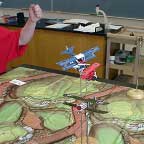 WW I Aerial
Combat (1914 - 1918 AD)
WW I Aerial
Combat (1914 - 1918 AD)Fast Play Rules for Students
 WW I Aerial
Combat (1914 - 1918 AD)
WW I Aerial
Combat (1914 - 1918 AD)Historical Background:
It was during World War I that the airplane became an important weapon of war. At the start of the war the planes were unarmed and were used for scouting. Soon the pilots were taking weapons with them on their flights. These early efforts were crude, but Dutch inventor Anthony Fokker eventually succeeded in synchronizing a machine gun with an engine so the weapon could fire through the propeller. This led to the "Fokker scourge" as the Germans used the new invention to dominate the skies. The Allies soon followed suit and battled the Germans for control of the skies over no man's land. Successful "aces", like the Red Baron, were lionized by the press and became living legends. By the end of the war the airplane's role in combat had expanded to include reconnaissance, artillery spotting, trench strafing, and bombing.
Battle 1: The first battle was very close, with the Germans shooting down 27 Allied planes, and the Allies retaliating by downing 23 German planes. The Allied pilots learned to fear the gaudy orange and black Albatross flown by Germany's top ace (9 victories). He often flew his patrols accompanied by Germany's top female ace (7 victories). Both were shot down but managed to land their mangled planes safely and return to duty. Any landing you walk away from is a good one! Two Allied pilots and one German pilot also managed to reach 5 victories.
Battle 2: The second battle was a lopsided victory for the Allies (37-22). One pilot, flying the red Fokker tripe favored by the Red Baron, became a double ace by tallying an astonishing 12 victories. This made him a prime target for the Allies, but they were unable to defeat him. The top Allied ace scored nine victories, and two other pilots reached eight victories. During this battle some of the pilots challenged each other to one on one aerial duels reminiscent of the early days of WWI when the pilots were known as "knights of the air." In one memorable sequence an Allied pilot used an unexpected Immelman turn to defeat a German pilot. The surprise maneuver sent the German down in flames before he knew what was happening. Another Allied ace, flying his trademark midnight black Spad VII, then repeated the feat, much to the embarrassment of the German pilot.
Rules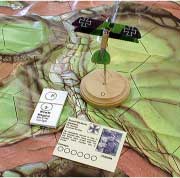
The models: I used 1/72 plastic model kits. The Allied planes were built from the following kits: Airfix Sopwith Pup, Airfix Sopwith Camel, Airfix Spad VII, and Toko Nieuport XI. The German planes were built from: Airfix Fokker DR1, Airfix Albatros DVa, Revell Fokker DR1, and Revell Fokker D VII. There are many other kits available, you should be able to get them for under $5. Students can built the kit in one 40 minute class period. Inspect their completed models and correct any obvious errors (wings on backwards). If you spray paint the models before or after they are built the students can finish them by painting details and applying the decals in a second 40 minute class period. There are many free paper airplanes on our website you can print and use. Another option is to buy die-cast airplanes. These planes look great, are durable, and come with a nice little stand that'll fit in the hexes. They are available from manufacturers like Corgi and Model Power. Corgi has a line of 3" planes for about $5.99, look for them at Wal-Mart.
Each Student gets:
The Board: The game is played on a 4' x 4' mat with
a 5" hex pattern. I used the vinyl "battle mat"
that comes with the old Battle Masters board game. These can be
purchased on eBay for $15 (a complete game is much more expensive,
try to get the mat when sold as a spare part, or part of an incomplete
game). Of course you can just draw your own hex pattern on a piece
of felt by cutting a hex out of cardboard and using it as a template
to trace the pattern. A 4' x 4' mat can handle eight pilots. I
played the game with large groups of kids so I ran the battle
simultaneously on three different mats.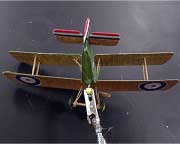
James Horton has made a version of the game that can be played with small printed counters on a smaller hex mad. You can download his game pieces in PDF format here German Planes, Allied Planes, Hex Map.
Airplane Stands: I took a pin with a round head and clipped off the pointy end. Then I heated the pin in a flame and inserted it into the underside of the plane. I secured the pin with a drop of hot glue. The base of the airplane stand was made from a 4" round wooden plaque I purchased at A.C. Moore's for $1. I bought some cheap cell phone antennas at Radio Shack - this game doesn't take altitude differences into effect, so the exact type doesn't matter. The ones I chose were 13" with 5 sections. I cut the button off the end and replaced it with an alligator clip which was attached with hot glue. You will want to find a more secure way to attach the alligator clip since the hot glue isn't really firm enough to do the job (after two days of hard use three of my stands lost their clips). Drill a hole in the wooden base for the antenna and secure it in the hole with, you guessed it, hot glue. Can you tell that I recently purchased a hot glue gun? I used permanent marker to draw an arrow on the wooden base to indicate the direction in which the airplane should point, and a letter for identification purposes. I experimented with adding weight to the base, but this proved unnecessary. The students can clip their planes to the stand, turn the plane to face the same way as the arrow, and adjust their antenna to any height they please.
Maneuver Cards: Each student gets a 20 card deck of maneuver cards from which he can choose his moves for the turn. I designed the cards in MS Word so they can be printed on business cards. Each card names the maneuver, illustrates how to move the plane, and describes it in words. The deck contains the following moves: 3 right turns, 3 left turns, 3 straight aheads, 3 right slips, 3 left slips, 1 ahead fast, 1 stall, 1 stall left, 1 stall right, and 1 Immelman turn. I wrote a different letter on the back of each deck so that when the kids drop or lose cards they can be returned to the right deck. A very nice set of maneuver cards created by James Horton can be downloaded in PDF format WW1ManCards.PDF. You can download the original maneuver cards as a word file man.doc or as two separate gif files maneuver1.gif and maneuver2.gif
Pilot Licenses:
The pilot license is an sheet, about
the size of an index card, where the students can record the damage
to their planes and record their victories. They were designed
to resemble baseball cards, with the name and picture of a WW
I ace, his victory total, and a brief biographical blurb. This
information was obtained from The
Aerodrome (http://www.theaerodrome.com/aces/index.html), a
fantastic web site. I laminated the pilot licenses so they could
be marked with dry erase markers. You can download the pilot license
cards as a MS Word file pilots.doc or
as seven separate jpg files: pilot1.jpg,
pilot2.jpg, pilot3.jpg,
pilot4.jpg, pilot5.jpg,
pilot6.jpg, pilot7.jpg.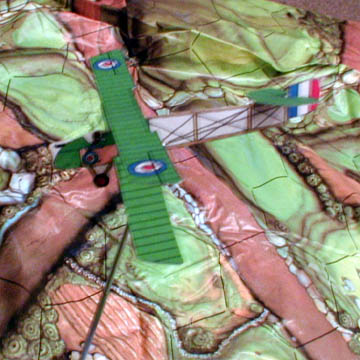
Deployment: The Germans and Allies start on any whole hex on opposite sides of the mat. You should line up the hex grain so the hexes run straight across from the German side to the Allied side. Planes should be positioned so the arrow on their base (and the nose of the plane) point at a hex side, NOT a hex corner.
Sequence of Play:
1. Choose cards
2. Play first card and move planes
3. Resolve shooting
4. Play second card and move planes
5. Resolve shooting
6. Play third card and move planes
7. Resolve shooting
Choose Cards: At the start of the turn each pilot must select three maneuvers from his deck of maneuver cards. Note that there is only one card for some maneuvers so these may not be used more than once per turn. The pilot should try to anticipate the maneuvers of his opponents and plan accordingly. The three cards selected should be placed face down in a stack in the order they will be used, the rest of the cards should be set aside. At the start of each new turn the three cards that were used are returned to the deck and may be selected again for the new turn. I gave each student the same deck of twenty cards, but you can add or remove cards to simulate differences in pilot quality or airplane performance.
Play Card and Move Planes: Each turn has three rounds of movement. When all players are ready everyone reveals their first maneuver card. Each player then moves his plane as indicated on their card. It may be helpful at the start to place the card next to the plane, and turn it to match the orientation of the plane. All moves take place at the same time. Planes should always end their move facing a hex side. This procedure is repeated for the second and third cards after shooting is resolved.
Planes in the Same Hex: Sometimes two planes will end up in the same hex. Planes in the same hex MAY NOT shoot at each other, they are assumed to be flying at different altitudes. Do your best to put both planes in the hex without losing track of their facing. The problem will resolve itself when the planes make their next move.
Resolve Shooting: Planes may ONLY fire at enemy planes that are in the line of hexes directly in front of their nose, they may not fire off to the sides or at an angle. Pilots must fire at the nearest enemy plane, and may ignore any friendly planes that are in the line of fire. If the target is one hex away the pilot rolls five dice, two hexes away roll four dice, and so on. Targets six or more hexes away are out of range. Hits are scored on rolls of 4-6. The target crosses of one circle on their pilot license for each hit received. When a plane has taken six hits it is shot down and removed from play, until then it may be flown normally. All firing is assumed to take place at the same time.
| Range | 1 | 2 | 3 | 4 | 5 | 6+ | Hits on roll of 4-6 |
| Dice | 5 | 4 | 3 | 2 | 1 | 0 |
Crash Landings: When a plane is shot down the pilot may be able to survive by landing the plane safely. Roll one die - on a roll of 1-4 the pilot survives, on a roll of 5 or 6 the pilot is put out of action (either killed, captured, or seriously wounded). If a student's pilot is put out of action they of course lose all their victories and must start over again with a new pilot license and airplane.
Victories: The pilot that shoots down an enemy plane
is credited with a victory. If two planes hit a target on the
turn it is shot
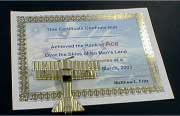 down
the victory is awarded to the player doing the most damage. If
both players inflicted equal damage they each roll a die, high
roll gets the victory (re-roll ties).
down
the victory is awarded to the player doing the most damage. If
both players inflicted equal damage they each roll a die, high
roll gets the victory (re-roll ties).
Aces: When a pilot gets 5 victories they become an ace. Ten victories is a double ace. When a pilot becomes an ace they get to throw one extra die each time they fire at an enemy plane. I gave the students an award certificate when they become an ace.
Leaving the Board: If a pilot's plane has received 4 or more damage points he may escape combat by flying off the mat. If he succeeds in getting off the mat all his damage points are restored and he may return to combat at the start of the next turn.
Returning to Combat: A pilot that has survived being shot down or left the mat voluntarily may return to combat at the start of the next turn. Their plane will start the turn undamaged. They must place their plane on any whole hex on any edge of the mat that is at least six hexes from the nearest enemy plane. This is to prevent them from flying in right behind an opponent. The hex where they start should be indicated to the other pilots before they select their maneuver cards for that turn. In my battle I used three different mats, and I served as air traffic controller by sending the players to the right table so that the balance of Allied and German planes remained about equal on each mat.
Duels: Occasionally two pilots will want to fight a one on one duel to settle a grudge, or determine which is the better pilot. Two players may declare that they are fighting a duel if they enter the mat on the same turn and both players agree. The two pilots will ignore the movements of all other planes on the mat, and may only fire at each other. Likewise, the other players must ignore the two dueling pilots, and may not shoot at them. The duel continues until one or both planes are shot down. The winning pilot must then fly off the mat before rejoining the dogfight.
Optional Rules: James Horton has developed a system where the pilot loses some control of his plane as it takes damage.
When you roll a hit die
| Die Roll | Result |
| 1 - 3 | Miss |
| 4 | 1 Damage |
| 5 | 1 Damage and lose 1 maneuver card (choose randomly) |
| 6 | 1 Damage and a critical hit (roll on critical hit table) |
| Critical Hit Roll | Result |
| 1 | Pilot gets 1 - 6 damage (roll die) |
| 2 | 1 Pilot hit and lose 1 maneuver card (choose randomly) |
| 3 | Gun hit or out of ammo, -1 die when firing |
| 4 | Engine hit, remove 2 power move maneuver cards, or any 2 maneuver cards if there are none |
| 5 | Fire, roll at start of every turn. 1=fire out, 2-4 fire continues, 5-6 fire continues and lose 1 maneuver card or take 1 damage (defender's choice) |
| 6 | Explosion, take 1-6 extra damage (roll die) |
Resources: Here are some useful resources for WW I dogfights